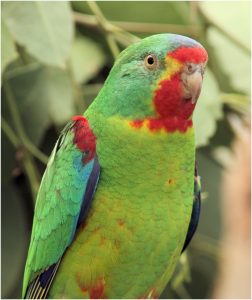Swift parrots visited Mt Majura in previous years from the end of March to the beginning of May. Most observations were from around the Hackett water tank and the Majura paddock east of Rivett Street where they fed on the nectar of Bundy and lerp of Yellow Box or took a bath in the drainage ditch close to the water tank.
Exciting news: Since the end of March 2022, flocks of Swift parrots have been spotted around the water course close to the Hackett water tank; view Canberra Nature Map photos here.
If you observe Swift parrots please contact Friends of Mount Majura with information on the date of observation, the time of the day, the location and the number of birds. Or register your observation with EBird, Canberra Ornithologists Group (see how to report Swift Parrot here) or Canberra Nature Map.

Swift parrots take a bath in the drainage ditch close to the Hackett water tank (Canberra Nature Map, 2nd April 2022)
Your observations are important. Swift Parrot is one of Australia’s most threatened bird species and is listed as critically endangered under Commonwealth legislation and under ACT legislation; the species is declared endangered in NSW. Click here to learn more about the Swift Parrots.
To view photographs of the species click on the Swift Parrot Gallery of the Canberra Ornithologists Group.
Mount Majura was host to a record number of endangered Swift Parrot, Lathamus discolor between the end of March and the beginning of May in 2005 and 2008. The parrots were most frequently observed around the lower Hackett reservoir off Rivett / French Streets feeding on the nectar of Bundy, Eucalyptus gonyocalyx and lerp – the sugary protection cover of sap-sucking insects – of Yellow box, Eucalyptus melliodora.
Swift parrots are bright grass green in colour. They have patches of red on the throat, chin and forehead, which are bordered by yellow. They have red on the shoulder and under the wings and blue on the crown, cheeks and wings. A distinctive alarm call of kik-kik-kik usually given while flying, a streamlined body, a long tail and flashes of bright red under the wing enable the species to be readily identified.
Swift parrots breed in Tasmania and migrate to mainland Australia in autumn. During winter the parrots are semi-nomadic, foraging in flowering eucalypts mainly in Victoria and New South Wales. Small numbers of swift parrots are occasionally recorded in the ACT, south-eastern South Australia and southern Queensland. The parrots choose larger trees for foraging and feed extensively on nectar and lerp from eucalypts during the non-breeding season.
Watch out for the parrots.
Many thanks.
Waltraud Pix



